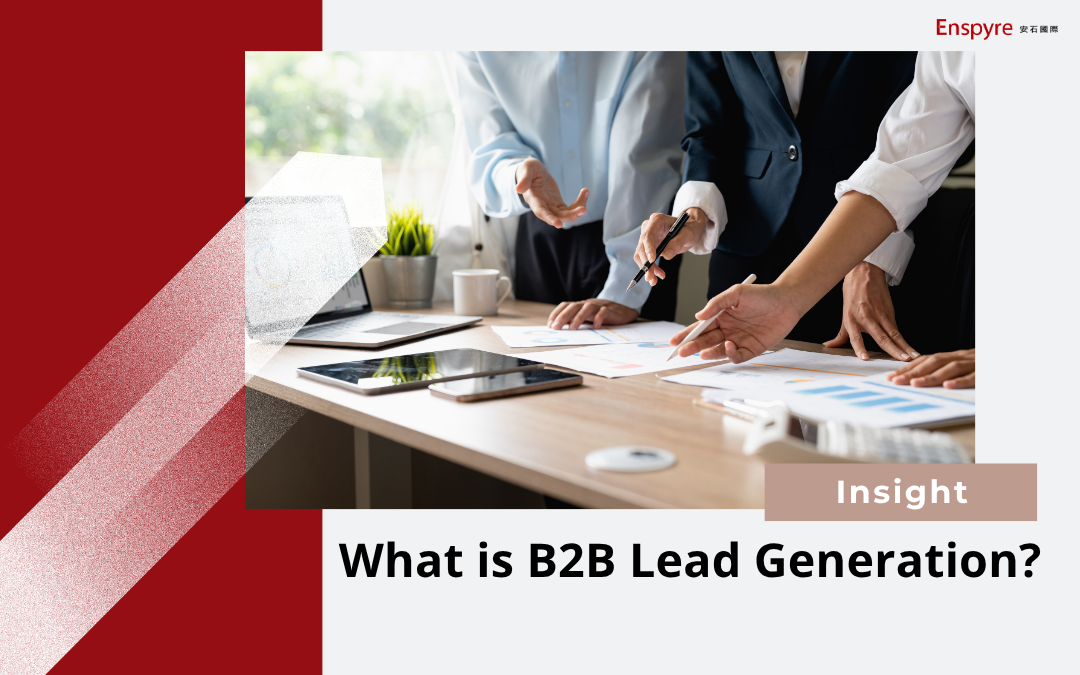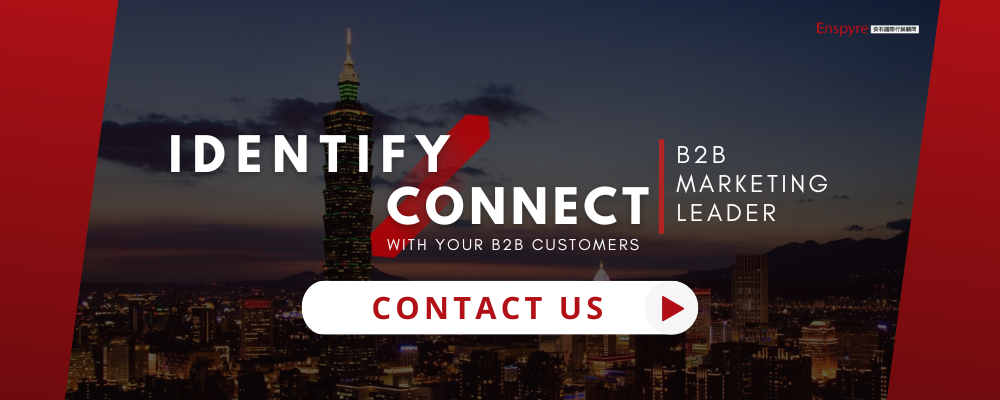Definition of B2B Leads
A B2B lead refers to a market opportunity that includes potential client company information, key contact details, and market needs and pain points. Unlike B2C, B2B leads involve longer decision cycles, multiple stakeholders, and higher purchase values, making building long-term relationships more critical.
Enspyre has been a leader in B2B Lead Generation in Taiwan since 2000 and we are excited to share our experience and expertise.
The Complete B2B Lead Generation Journey
B2B Lead Generation is a comprehensive process of exploring market opportunities, consisting of two core stages:
- Identify Target Markets: Discover the most valuable potential markets
- Connect with Qualified Prospects: Establish connections through various channels
This process requires close collaboration between marketing and sales. Marketing is responsible for discovering and nurturing leads, while sales handles conversion and closing contracts. Together, they drive business growth.
A B2B Lead Generation Report Should Include 3 Levels:
A comprehensive lead profile helps businesses understand:
Level 1: Know Your Customers
Company Information: Company name, industry category, size (employee count, annual revenue), location, website
Stakeholder Information: Name, title, department, decision-making authority, contact methods (phone, email), LinkedIn profile
Level 2: Understand Customer Needs
Needs and Intent: Current pain points, budget range, decision timeline, existing solutions, level of interest in solutions
Interaction Records: Initial contact channel, content download history, website browsing behavior, past communication records
Level 3: Prioritize Customers
Scoring and Stage: Lead scoring, customer lifecycle stage, priority ranking, estimated closing probability
B2B Lead Generation: Bringing Marketing and Sales Closer Together
Let’s recall a common business scenario: The marketers want to understand the latest customer status but have to wait for sales to extract data from the database—this wait could be a week or even a month. On the other hand, sales complains that the leads provided by marketing are poor quality, with most not being qualified customers at all. Over time, both sides accumulate grievances, blame each other, and ultimately impact overall business performance.
The lead generation process was created to solve this marketing and sales collaboration problem. It helps marketing and sales teams better manage every potential lead, establish collaborative mechanisms, drive data-driven decisions, and reduce internal disputes and friction.
How to Prepare for B2B Lead Generation?
When preparing for B2B lead generation, regardless of whether you have a clear target market, this approach can achieve different outcomes:
1. Clear Target Market
Generate leads while delivering high-value content marketing information to attract customers to provide their information and maintain engagement.
2. Uncertain Target Market
In the early stages of lead generation, design A/B testing for different markets, cross-collect feedback and needs from different target markets, then focus on high-value potential customers to design content marketing.
You can read Enspyre’s Success Story for more insight → Master Group Uses A/B Testing to identify Target Market
B2B Lead Generation Tools
| Inbound Marketing | Outbound Marketing | |
| Definition | Attract potential customers proactively by providing valuable content | Company actively contacts potential customers to create opportunities |
| Time to Results | 6-12 months | 3-6 months |
| Suitable Stage | Stable products | 0-1 new market/new product business expansion |
| Main Tools | SEO (Search Engine Optimization), social media management, publishing whitepapers or e-books | Online: Digital advertising (LinkedIn, Meta, keyword ads), cold outreach
Offline: Trade shows, business networking, seminars |
Enspyre have been trying AI lead generation method, you could read more from this article: AI-Powered B2B Lead Generation: 3 Steps to Work Smarter, Not Harder
High-Value Content Marketing That B2B Customers Are Most Interested In
When you plan to prepare high-value content to attract potential customers to contact you, here are four most effective content types:
1. Success Case Studies: Make Key Customers Your Magnet
Customer case studies are the most powerful marketing tool because they provide social proof, demonstrate real results, and reduce decision-making risk.
How to create effective case studies? Choose representative customers from the same industry as your target audience, present in a structured “Challenge → Solution → Results” format, and demonstrate value with specific numbers (such as 30% efficiency improvement, NT$500,000 cost savings).
The magnet effect of key customers is particularly evident: Well-known enterprise cases enhance brand credibility, industry leader endorsements attract peer attention, and success stories can also bring referral opportunities.
▸ Success stories → Find key customers, unlock new B2B markets!
2. Localized Content: Show Your Respect for Customers
Localized content is crucial, especially when international companies enter new markets. It’s not just language translation, but includes four levels of localization: culture, regulations, industry, and visual.
For example, using local language habits rather than awkward translations, understanding local business decision-making processes, mentioning local regulatory requirements, and using local cases and scenarios. Taiwanese businesses particularly value “relationships” and “trust” building. If international companies can demonstrate deep understanding of the Taiwan market, it will significantly enhance content resonance and lead conversion rates.
3. Whitepapers: Demonstrate Industry Expertise
Whitepapers are in-depth professional reports of 5,000-10,000 words or more, used to establish leadership in the industry. Compared to blog posts (1,000-2,000 words) or e-books (3,000-5,000 words), whitepapers provide deeper industry insights and solutions.
Topics can include industry trend analysis, viable methods, research reports, policy and regulatory interpretations, etc. By setting up download forms, whitepapers can collect contact information for high-quality leads and serve as professional endorsements during sales proposals.
4. Research Surveys: Create Industry Status Content That Interests Customers
Research surveys provide exclusive data and insights, can attract media coverage, and establish industry authority. These include industry status surveys, challenge and pain point surveys, trend forecasts, and benchmark studies. For example, the “2025 Taiwan Enterprise Digital Transformation Status Survey” or the “Taiwan Top 100 Companies ESG Status Survey.”
One research survey can generate over 10 blog posts and continuously provide 3-6 months of content materials, while also providing long-term brand value enhancement and media exposure and SEO benefits.
Proactive Approach – Cold Calling is the Best Lead Generation Method
If you want to spread your high-value content to precise customer groups, compared to passive strategies of waiting for customers to come (such as SEO, content marketing), cold calling is a powerful weapon for proactive outreach. It has three irreplaceable advantages:
1. Dual Effect: Collect Market Intelligence While Building Customer Relationships
Cold calling is not just a sales tool, but an effective way to conduct market research and build relationships. Each call can achieve two goals simultaneously:
Immediate Market Intelligence Collection: Understand customer real needs, verify product-market fit, grasp industry trends, and collect competitive intelligence. For example, a SaaS startup collected feedback from over 200 companies through 3 months of cold calling, discovered strong market demand for a certain feature, and adjusted the product roadmap accordingly.
Build Long-term Customer Relationships: Voice conveys warmth and sincerity, real-time interaction builds trust. Even if customers don’t need it now, through continuous value provision and industry insight sharing, they can be nurtured into future opportunities.
2. Proactive Outreach: Help Your Customer Lists from 0 to 1
The challenges faced by new markets or startups are that they have zero brand awareness, no natural traffic, and customers won’t proactively find you. SEO and content marketing take 6-12 months to see results, and digital advertising is costly and difficult to target precisely.
The speed advantage of cold calling is obvious: In the first week, you can reach out to 50–100 individual prospects (not companies); in the first month, generate 20-50 qualified leads; within 3 months, complete initial market validation—over 10 times faster than waiting for natural traffic.
3. Precise Targeting: Don’t Waste time on Non-Customers
Time is the most precious resource, and low-quality leads will drag down the morale of the sales team. Precise targeting can improve cold outreach efficiency, shorten sales cycles, and reduce customer acquisition costs.
How to achieve precise targeting?
I. Define Ideal Customer Profile (ICP): Filter from three dimensions: company level (industry, size, location), needs level (pain points, budget, timeline), decision-making level (position, decision-making authority).
II. Select Development Direction: Confirm market development direction through Enspyre’s exclusive B2B enterprise database.
III. Prepare Communication Strategy in Advance: Anticipate customer pain points and needs for different industries and even individual companies, list communication priorities.
IV. Lead Inquiry and Identification: Contact customers, understand current pain points, determine whether customers meet sales qualifications.
Enspyre’s B2B Lead Generation Services places more emphasis on:
Customized Communication Content: Use the BANT framework (Budget, Authority, Need, Timeline) to adjust communication strategies for different industries. For example, manufacturing emphasizes production efficiency and cost control, finance emphasizes compliance and information security, retail emphasizes digital integration and member management.
Lead Inquiry and Identification: Use “guided communication strategy” to understand customer status and determine lead quality. Customers meeting 3-4 criteria receive high-priority follow-up, those meeting 0 criteria are politely ended without wasting time.
The final data clearly shows: Compared to general enterprises using a shotgun approach to develop 1,000 companies with only 5% conversion rate; precise targeting development contacts 200 precise enterprises with 20% conversion rate, improving efficiency by over 4 times.
If you want to know a compete business development strategy, you can read this article: New Lead Generation Strategies: B2B Cold Outreach for High-Performing Sales & Marketing Teams – Enspyre
B2B Lead Generation FAQs
Q: What are the keys to successful B2B lead generation?
The key to success lies in listening to market signals, understanding customer needs and pain points, uncovering non-public information, identifying customers who meet sales qualifications, and maintaining engagement with them.
Q: How should internal marketing or sales teams divide responsibilities to align goals?
According to sales funnel theory, marketing is responsible for discovering and nurturing leads, while sales is responsible for conversion and closing.
Companies can establish several KPIs such as “MQL qualification rate,” “SQL qualification rate,” and “conversion rate of leads from individual channels” to help marketing and sales better focus on effectiveness.
If the company has a Customer Relationship Management (CRM) system, it can eliminate the time both parties spend extracting and verifying data.
Launch a New B2B Lead Generation Strategy Now
B2B lead generation requires close collaboration between marketing and sales. Choose Enspyre’s “B2B Lead Generation Service” to help you quickly validate markets and continuously advance market opportunities during 0-1 market expansion or when encountering business development bottlenecks!
Three Immediate Action Recommendations:
- Establish a Precise Ideal Customer Profile: Don’t cast a wide net, focus on the most valuable customer segments
- Prepare High-Value Content: Customer case studies, whitepapers, research surveys to attract potential customers
- Partner with Professional Teams to Accelerate Market Development: Especially when lacking experience, resources are limited, and there’s time pressure
Lead generation is not a one-time activity, but a continuously optimized system. Through data-driven decisions, regular ROI reviews, and constant strategy adjustments, you can build a stable and scalable customer acquisition engine to drive continuous business growth.
Enspyre has operated B2B lead generation teams for over 20 years, positioning itself as the strongest support for enterprise marketing and sales teams. Through clear division of labor, transparent communication, and shared goals, we can achieve 1+1>2, creating higher overall effectiveness.





